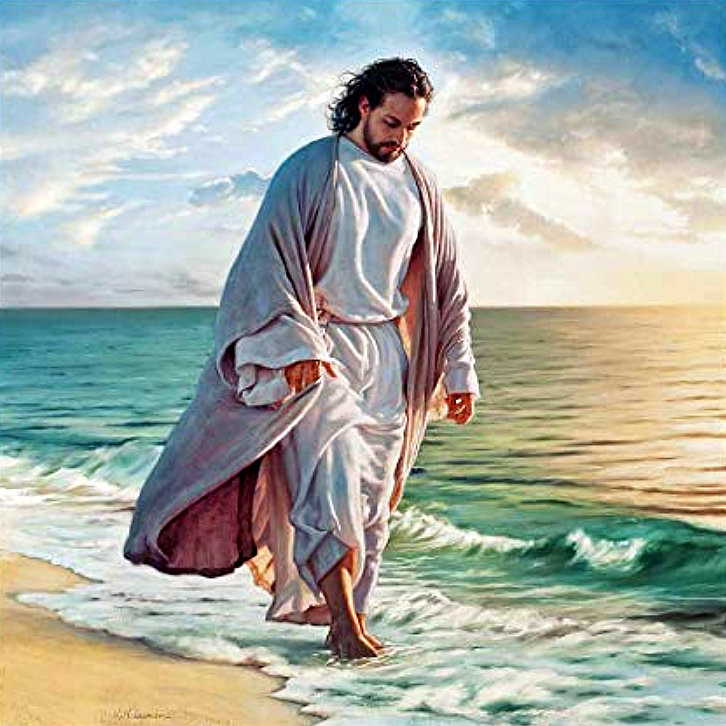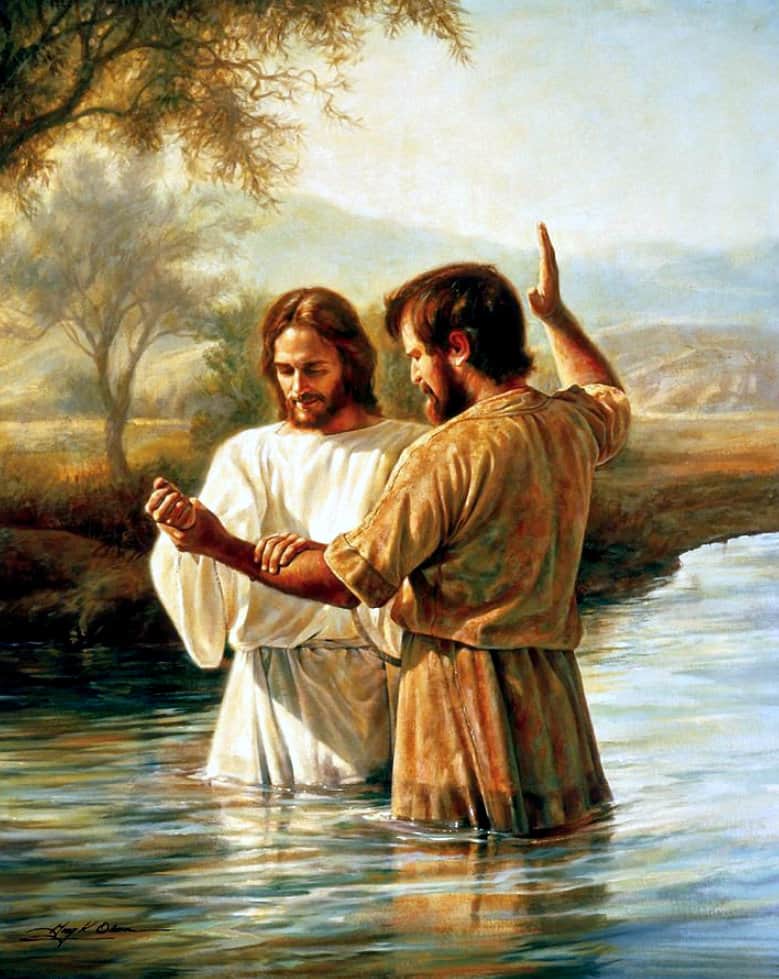The Living Teachings of Jesus
Jesus steps into ministry
Most people who are at all aware of the life story of Jesus know that he left doing carpentry with Joseph when he was about 30 years old and started ministry as a mature unmarried man. According to the Gospel account in Matthew 3, Jesus knew the time had come for Him to begin when John ( the son of Zechariah and Mary’s relative Elizabeth, also known as “the baptist”) began proclaiming the coming of the Messiah and calling people to repentance and baptism.
Jesus responded to John’s call by presenting himself to be baptized “to fulfill all righteousness” and receiving the Holy Spirit in the form of a dove when he emerged from the waters of the Jordan. Immediately after being baptized and being empowered for ministry, Jesus began experiencing intense mental and spiritual pressure to yield Himself over to demonic temptation, as reported in Luke 4:1-13. His response was to enter into a prolonged 40-day time of personal isolation, prayer, fasting, and resistance using the Word of God.
When Jesus emerged victorious from His trials, He began calling disciples and proclaiming, teaching about, and demonstrating the power of the Kingdom of God by healing the sick and performing signs and wonders.
Matthew 4: 17 – From that time Jesus began to preach, saying, “Repent, for the kingdom of heaven is at hand.”
Calling the Disciples
Matthew 4:18-22 – While walking by the Sea of Galilee, he saw two brothers, Simon (who is called Peter) and Andrew his brother, casting a net into the sea, for they were fishermen. And he said to them, “Follow me, and I will make you fishers of men.” Immediately they left their nets and followed him. And going on from there he saw two other brothers, James the son of Zebedee and John his brother, in the boat with Zebedee their father, mending their nets, and he called them. Immediately they left the boat and their father and followed him.
How many people have heard that in the very early days of His ministry Jesus called 12 Disciples to follow Him? How many know that none of the ones who were called knew Him before then but that they all immediately dropped everything that they were doing, left their vocational work behind, followed Him wherever He went for the next 3 years, and only one of them turned against Him at the end? Anyone who has been involved in trying to organize other people will be able to see that the capacity Jesus demonstrated in this one critical task alone is an absolute miracle that demonstrates the dynamic power of His presence and personality.
In the Imago Dei or Image of God
Jesus knew beyond any shadow of doubt that human beings were created in God’s Image and that He had been sent into the world as the incarnated Son of God the Father. We’ve seen earlier in the Creation narrative that, as a capstone of His creation, after God had prepared the earth as a habitation and after He had created the fish, the birds, and the other animals, He then created mankind. However, there was a difference: When God created the vegetation and the animals, He made them all “after its/their kind“, a phrase that occurs ten times in Genesis 1:11-25. When He created Man, He made him after the God-kind as noted below:
Genesis 1:26-27 – Then God said, “Let us make man in our image, after our likeness. And let them have dominion over the fish of the sea and over the birds of the heavens and over the livestock and over all the earth and over every creeping thing that creeps on the earth.” So God created man in his own image, in the image of God he created him; male and female he created them.
After the Fall, man is still said to be in God’s image (Genesis 9:6; Acts 17:28; 1 Corinthians 11:7) and likeness (James 3:9). However, this image was defiled by man’s rebellion at the Fall, and all aspects of God’s image became corrupted. By contrast, these aspects remained pure, uncorrupted, and undefiled (see synonyms of holy) in Jesus, who was and is “the image of the invisible God” (Colossians 1:15) and “the express image” of God (Hebrews 1:3), both in His life on earth and in Heaven. Jesus took the reality of the Imago Dei, incorporated it with an awareness of His incarnation, and confirmed the identity recognized in John 1:14 when he responded to Philip:
John 14:9 – Jesus said to him, “Have I been with you so long, and you still do not know me, Philip? Whoever has seen me has seen the Father. How can you say, ‘Show us the Father’?
The reality of spiritual life
Everything Jesus said and did demonstrates His deep understanding that the world which we inhabit has three distinct and interrelated aspects: physical (physis or soma), psychosocial (psyche), and spiritual (pneumo). Because we have all fallen into the corruptions of the pervasive sin which is intrinsic to our fallen lives and world, our bodies, souls, and spirits need to be cared for, nourished, and restored. These tasks require two things: the initiative and power of God’s grace and our understanding and cooperation. We need to be rescued (saved or redeemed), cleansed (sanctified), and restored to the unique Imago Dei in which we were created when we were first conceived or we will slide further and further into corruption.
Jesus spoke and acted with the clear recognition that the universe has an intricate spiritual dimension inhabited by the pure and perfect spirit of the living God and by countless created spiritual entities about which our knowledge is quite limited. With a little self-reflection, we may develop a recognition, as David noted in Psalm 42:11, that we have a personal spiritual identity that is aware of the condition of our souls. We might sense that there are spiritual connections between us and others and that there are personal forces in the universe that seem to have effects on our thought life, both positive and negative. Jesus knew all about this and was able to command the negative spirits (demons), spiritually discern “which way the wind was blowing” at all times, and call forth the presence and power of the Holy Spirit of God.
John 3:1-8 – Now there was a man of the Pharisees named Nicodemus, a ruler of the Jews. This man came to Jesus by night and said to him, “Rabbi, we know that you are a teacher come from God, for no one can do these signs that you do unless God is with him.” Jesus answered him, “Truly, truly, I say to you, unless one is born again he cannot see the kingdom of God.” Nicodemus said to him, “How can a man be born when he is old? Can he enter a second time into his mother’s womb and be born?” Jesus answered, “Truly, truly, I say to you, unless one is born of water and the Spirit, he cannot enter the kingdom of God. That which is born of the flesh is flesh, and that which is born of the Spirit is spirit. Do not marvel that I said to you, ‘You must be born again.’ The wind blows where it wishes, and you hear its sound, but you do not know where it comes from or where it goes. So it is with everyone who is born of the Spirit.”
As you read the Gospel accounts, take note of every mention and demonstration that Jesus makes about spiritual life and then ask yourself: Do I actually know what’s going on in the reality in which I live and move and have my being? Have I been born again? Can I even see the Kingdom of God? What in heaven and earth is this all about?
Living, Embodied Teachings
Who a person really is and what they do often counts more than what they say. In the unique integrity of Jesus, everything about Him is of equal value and complements the rest. John is the Gospel writer who captured the reality of Jesus more clearly than the others by recording many of His more compassionate, self-revelatory, and prophetic sayings. The following list encompasses John’s profound introduction to Jesus’ view of Himself and His calling.
The 7 “I am” statements of Jesus
- I Am The Bread of Life
- I Am The Light Of The World
- I Am The Door Of The Sheep
- I Am The Good Shepherd
- I Am The Resurrection and The Life
- I Am The Way, The Truth, and The Life
- I Am The Vine
You may appreciate reading Stephen Altrogge’s article as you meditate on the meaning of each statement.
Fulfilling the Word of God
Throughout the accounts of Jesus’ ministry, we find Him quoting and using passages from throughout the Hebrew canon of scriptures at the time (the Tanakh or what we now call the Old Testament) to articulate His message. There are three sections of the Tanakh: the Law (Instructions or Torah), Prophets (or Nevi’im), and Writings (or Ketuvim), and Jesus referenced all three. As He clearly confessed in the following verse, He was not replacing the guidance and instructions that God the Father had already given and which had already been received and written down but was living them out as a “living letter” to demonstrate in His own person the kind of wise and compassionate divine intervention that could be anticipated if people would but heed the call of God on their lives and live it out as He did.
Matthew 5:17-20 – “Do not think that I have come to abolish the Law or the Prophets; I have not come to abolish them but to fulfill them.”
For a full list of examples of now familiar scripture passages that Jesus quoted and relied upon from throughout the Tanakh, please read Rich Robinson’s article on “Jesus’ References to Old Testament Scriptures“.
Navigation Notes
By continuing to use the Up and Down buttons in the middle you can navigate directly through our timelines. For each timeline we have been taking a detour using the side buttons to investigate events and topics noted in the current chart. In our Ministry tour we are looking more closely at the teachings, parables, and miracles of Jesus.


